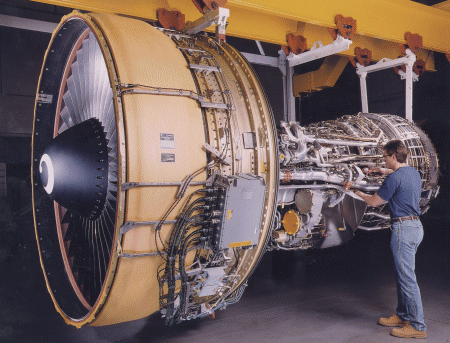Guy Norris/LOS ANGELES

General Electric is preparing for vital fan blade containment tests early next year that will pave the way for freezing technology input in its proposed growth version of the CF6, the -80G2.
The hybrid wide chord fan is key to increasing the thrust of the CF6 family to the 67,000-70,000lb (298-310kN) range for proposed aircraft such as the Boeing 767-400ERX and 747-400X. Should the tests be successful, however, the "hybrid fan will be the design of choice for all our engines in the 90-100in [2.3-2.5m]-diameter range," says CF6 project general manager, Roger Seager.
Unlike other wide chord fans of similar dimensions, the GE design is not hollow and diffusion bonded, but contains pockets filled with composite material. After forging and machining, the pressure sides of the blades are machined out in a "spider's web" arrangement and pockets in the low-stress areas are filled with composites. "It gives it the lightness of hollow titanium blades, but with great strength," says Seager. "The key is how to keep the composite inside it, and the issue will be containment. The question is what will happen in the event of a blade-out?"
GE's analysis suggests the composite material will shred and the blade will effectively concertina, producing a relatively low level of impact energy on the containment area. The knock-on effect means that the thickness and material of the containment collar could be reduced slightly, leading to weight and airflow benefits.
"We assume it will allow us to move from Kevlar to steel, which will increase diameter from 93in to 93.8in," Seager adds. Another potential feature being studied for the engine is the load reduction device (LRD). This has been tested on a GE90 fan rig and will be part of the GE90-115B as well as future CFM56 designs. In the event of a blade failure, the LRD effectively decouples the fan from the shaft, reducing stresses to the rest of the engine and airframe.
Core improvements are also being developed to enhance performance for the G2 which Seager predicts could be "available within 24 months given a go-ahead this year". The high-pressure (HP) compressor will have three-dimensional aerodynamically designed blades from stage seven upwards, while the HP turbine will be based on the Rene R88 design perfected for the B7F/B8F engines developed for the 767-400ER.
The so-called "boltless" turbine design incorporates the higher- temperature resistant R88 material, has an inter-stage seal (instead of a conventional thermal shield), which uses bayonet fittings rather than retainer bolts, reducing windage losses.
Source: Flight International























